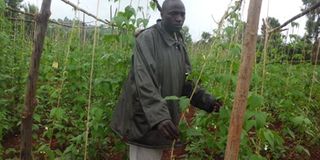New technology to help farmers use fertilisers, boost their yields

Some of the newly released bean varieties are the climbing type. Therefore, with the proper farm practices, farmers will get the best of them. PHOTO BY LOMINDA AFEDRARU
Most people who know about Uganda and its natural resources have the impression that the country is blessed with fertile soils. Yet this is contrary to what soil scientists have found.
A study done by National Agricultural Research Laboratories (NARL) Kawanda shows that Uganda faces severe soil nutrient depletion. This is because many farmers keep tilling the land over and over again without applying practices that maintain soil fertility.
Calculate the amount
Therefore, it is recommended that small holder farmers should maximise fertiliser use alongside organic manure to improve soil nutrients.
The most important ingredients required to increase soil fertility are Nitrogen, Potassium and Phosphorous (NPK). Other secondary components include calcium, magnesium, sulphur, copper, iron, manganese and zinc.
The scientists have come up with Uganda Fertiliser Optimisation Tool (FOT). It is computer-based tool used to calculate the required amount of fertiliser as per the monetary fund allocated for a specific agricultural activity per unit hectare. It also indicates what a farmer will earn from the output invested.
NARL is working on this project with University of Nebraska. In US, the FOT has been applied by farmers and has worked well.
The profit
Dr Cranmer Kayuki Kaizi from NARL, explains that what is considers the land area the farmer wishes to plant for a particular crop and expected commodity value at harvest, the cost of fertiliser and the finance available to the farmer for purchase of fertiliser.
The profitability varies greatly depending on which nutrient is applied to which crop and at what rate.
FOT was developed for crops such as sorghum, beans, rice, groundnuts and maize. Currently, the team is in the process of developing this tool to cover other crops.
It is availed to extension workers who show farmers on how to calculate the fertiliser rate for a particular crop and estimate average yield and net returns.
The target is extension workers in various African countries: namely, there are Uganda, Kenya, Tanzania, Rwanda, Mozambique, Zambia, Malawi, Ethiopia, Ghana, Burkina Faso, Nigeria and Niger.
Guide farmers
Calculations are made with MS Excel, and a farmer will be able to know that if he or she applies 50kg of urea on one hectare, the yield will amount to 44kg of maize grain per hectare.
For the case of rice, if fertiliser is purchased amounts to $60 (Shs204,900) to the hectare, the farmer will be in position to reap $700 (Shs2,390,500) per hectare. Therefore, the tool enables farmers to apply fertiliser depending on the economic return.
The tool also helps guide the farmers on which crops to invest in and the fertilizer usage. In Uganda, it has been tried in Kapchorwa, Aleptong, Arua, Tororo, Sironko, Apac districts and it is to be introduced in Kisoro, Kabale and Ntungamo districts.
The implementing partners, CABI and NARL have trained Community Knowledge Based (CKB) trainers in Kapchorwa and Mbale district, where the software is loaded on mobile phones.
Increased yields
Sam Satya, the coordinator, explains that using FOT has advantages such as farmers with little cash at hand being in position to buy fertiliser at whatever quantity in a bid to get good yield.
Farmers who growing other crops not covered by FOT are at a disadvantage because they are not able to make use of it.
So far, about 300 farmers in Mbale and Kapchorwa have adapted the FOT technology and they have realised increased yields.
Farmers have learnt which quantity of fertiliser to purchase for an acre of land because previously they were applying 50 kg of either urea or diammonium phosphate (DAP) on one acre. Yet, by applying FOT, a farmer can use 30 kg of urea and 12 kg of DAP for one acre and still reap better yields.
A farmer who used 50kg of urea would harvest eight bags of maize but now by using less quantity of urea, he or she can harvest 20 bags of maize. This means application of the tool is useful.
Farmers are advised to measure the fertiliser and mix it with soil per hole, and by the time it spread across the field and it rains, the fertiliser would have been absorbed.
Managing soil fertility
In case of farmers lack money to purchase fertiliser mainly urea and diammonium phosphate (DAP), they may grow legume crops, which fix nitrogen in the soil.
Cover crops such as Macuna, Chlotolaria and soya bean are key nitrogen-fixing crops that farmers are encouraged to grow during fallowing of their fields.
It is also advisable for farmers to embrace use of inorganic fertiliser like urea because 100kg of urea contains 46% nitrogen compared to 100kg of organic manure, which contains 1% nitrogen.
However, planting of legume crops is a good practice farmers that can apply in managing soil fertility.




